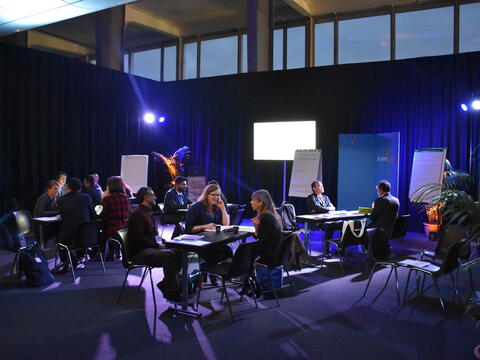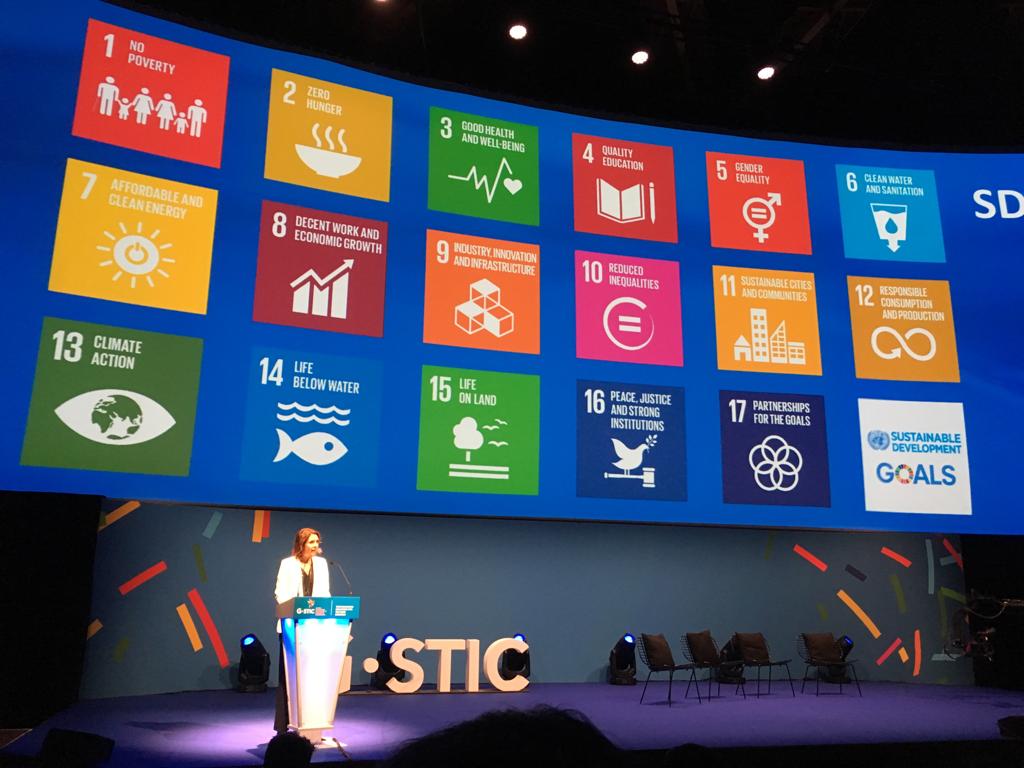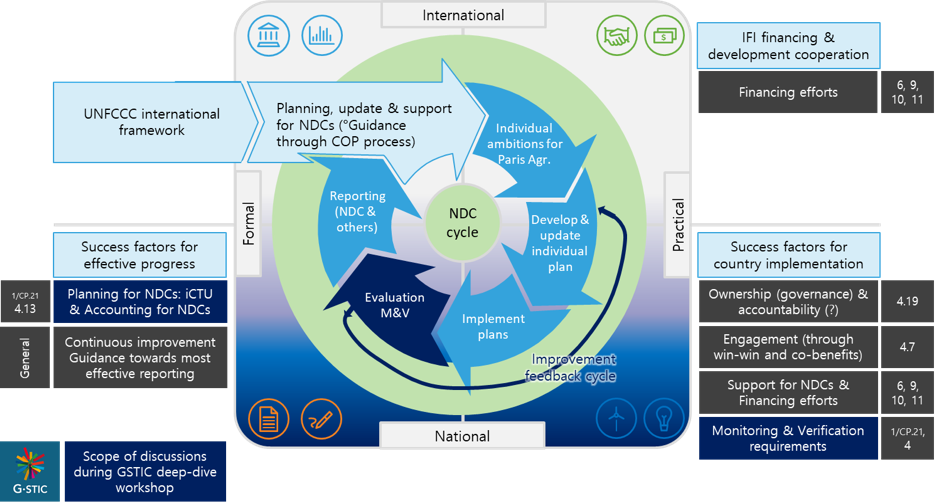G-STIC & CTCN Climate Technology Matchmaking Event: Ambition vs. implementation of sustainable energy strategies
13 December 2019, Dr. Silvia Emili, Category: All insights, News, Tags: climate ambition, climate finance, climate innovation, CTCN, energy, energy solutions, G-STIC, NDCs, SDGs

Earlier in November, I participated in the Climate Technology Centre and Network (CTCN) event in Brussels, organised as part of the G-STIC conference. CTCN, with support from the European Commission, organised a private sector matchmaking event for the National Designated Entities (NDEs) of Asia-Pacific, network members and climate technology service providers, including private sector and international organizations.
While the G-STIC conference touched broader themes linked to SDGs (Sustainable Development Goals), from health to education and climate change, it showcased practical solution from the private sector to tackle the most challenging issues of our times, from circular economy solutions, to blue technologies and carbon capture.
In this article, I summarise my main takeaways from attending the UNFCCC session on ‘Integrating sustainable energy strategies in the NDCs’ and from the CTCN matchmaking session which followed.
Integrating sustainable energy strategies in the National Determined Contributions (NDCs)

G‐STIC was launched to catalyse the process of better harnessing science, technology & innovation to achieve the SDGs by 2030
The first session I attended, organised by UNFCCC Secretariat and with participants from IRENA, UNIDO, CTCN and ETC/VITO, focused on discussing practical solutions for bringing the NDC process to life in order to streamline energy strategies and improve transparency and monitoring while reflecting higher ambitions.
Divided in working groups, we brainstormed on improving MRV systems, ways to bring the NDC process to life in terms of ownership and engagement, and the types of effective technologies that could contribute to achieving the expected targets.
What emerged is that despite energy planning being crucial for long-term mitigation and adaptation strategies, many NDCs still present vague and non-ambitious goals for the energy sector. Moving forward, successive NDCs should integrate ambitious climate action of non-party stakeholders that are already implementing mitigation or adaptation measures, such as the private sector. Additionally, the NDC process should offer opportunities for engagement and for collaborative planning, taking into consideration the country context and the reality on the ground.
According to Nurzat Myrsalieva, Senior Expert Energy Systems and Infrastructure at UNIDO, the plans for industrial sectors in NDCs area often too vague and they unfortunately reflect the capacity of countries to improve efficiency in the industrial sector. Data to establish a baseline is often scattered and hard to collect, and countries may lack the capacity to collect data in a coordinated way and to analyse it in a way that is useful for planning purposes.
Roland Roesch, Deputy Director of IIRC (IRENA), reflected on the low ambition of NDCs compared to the scale of the required change. Current plans are far below what is needed to achieve energy systems transformation. The ambition needs to be increased, particularly looking at the whole range of renewable energy available, at different technologies and sectors.
How can we harmonise stakeholder consultation in NDC planning?
My group focused on discussing barriers and opportunities for involving stakeholders, from the private sector, to local government and civil society, into NDC planning.
An NDC is a national instrument that has to be broken down to the local level in order to effectively achieve the stated goals. The ownership of NDCs has to shift from something abstract to something very concrete in order to implement the actions. Additionally, the refinement and update of NDCs should be participatory in nature, where stakeholder consultation is an integral part of the process.
Our group concluded that:
- Capacity development of local and regional government is key to bridge the information gap, and links must be developed between city-level initiatives, regional and national planning
- The funding system needs to move away from a project-based approach towards long-term capacity for low-carbon development. A link between international funding to local-level funding will be necessary to increase effectiveness and ownership
- Climate action must be made relevant to the actors on the ground, strengthening messages around climate-related activities and co-benefits for socio-economic development
- Information flows need to reach those whose lives are directly affected by climate change and funding opportunities
“The beauty of the NDC is that is not defined, it’s tailored to regional and national needs. It is our task to allow exchange and to ensure that the NDC reflects country processes, being participatory and locally owned” Bernd Hackmann, UNFCCC

CTCN event: plenary session and matchmaking event
The plenary session discussed challenges and opportunities for implementing energy solutions and channeling climate finance where it is needed the most.
Unsurprisingly, one of the most pressing challenges discussed revolves around attracting the private sector to play a key role in driving transformational change in the energy sector. However, as the representative from UNIDO stated, partnerships will be the only approach to achieve both the 2030 agenda and the mitigation and adaptation goals. Dialogue between private and public sector, as well as academia and civil society will be key to connect silos and to build a multi-disciplinary approach that drive transformation into the energy sector.
In terms of technologies, Guy Vekemans from VITO affirmed that modularity and flexibility should be key attributes for deploying clean energy technologies, “It comes all back to flexibility, solutions need to be applied in different conditions and you need to take into account that communities are evolving entities”.
However, despite technological fitness, business models have a key role to play here. Deploying technologies through delivery models that can leverage women’s networks; designing financial mechanisms that create opportunities for SMEs to benefit from climate finance, as well as innovating the business model design to provide services instead of sale of products. These are all potential angles to tap into when looking at business models for clean energy technologies.
“What can be done to mobilize the full potential of women? Three key points: Representation, Rights and Resources. For example, the question whether a woman can open a bank account or own land it is crucial to [understand] whether she can play a role in energy transformation.” Kirsten Meijer, WECF – Women Engage for a Common Future
Transforming goals into strategies
The G-STIC conference, and particularly the CTCN Matchmaking event, have been a great opportunity to share lessons learned and best practices with energy and climate sector stakeholders. Similarly to previous CTCN events that I attended, I found it particularly energising to engage in conversations with the National Designated Entities to understand their needs, challenges and potential solutions for climate action. In my view, is not a lack of ambition, but rather a lack of appropriate resources to transform ambitious goals into actionable practice. Looking forward to 2020, when countries will submit their updated NDCs, I hope to see improvements on the coordination mechanisms available at country level to transform these goals into strategies.
Join the conversation by posting a comment below. You can either use your social account, by clicking on the corresponding icons or simply fill in the form below. All comments are moderated.